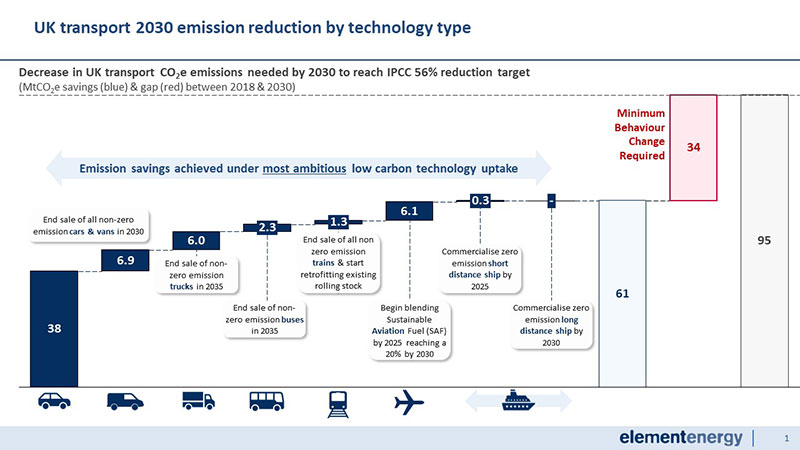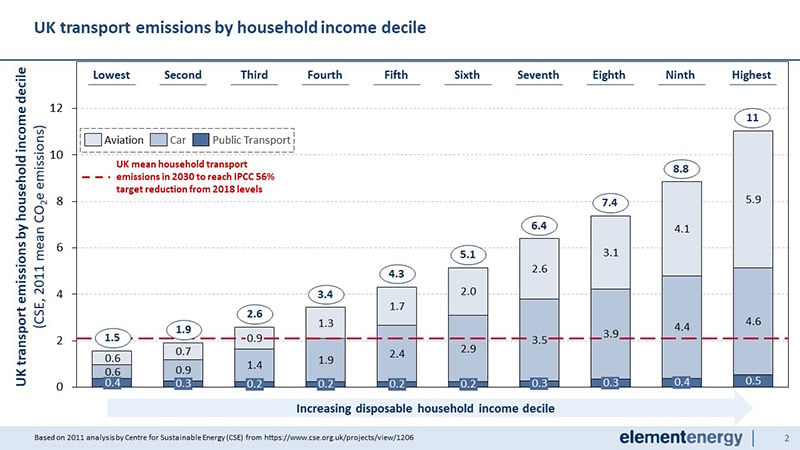The COP26 talks in Glasgow are days away and world leaders are being urged to increase the ambition of the carbon emission reduction targets set out under the Paris Agreement. The world has now warmed 1.2°C above pre-industrial levels. The latest IPCC evidence makes it clear that the social, environmental and economic impacts of 2°C warming will be much worse than 1.5°C, making it imperative we stay as close to 1.5°C as possible. Greater ambition is necessary to avoid the worst impacts of climate change we are already starting to see.
While most governments’ policies and pledges focus on achieving net zero by 2050, it is the emissions avoided in the next few years that will have the greatest impact. Reducing emissions early prevents emission build up. Transport is responsible for 16% of global greenhouse gas emissions and is therefore one of the key sectors requiring radical change. Today we see welcome policy efforts from governments around the world to shift transport technologies from those based on fossil fuels to renewable energy. But climate targets will not be reached if behavior change and a ‘just transition’ do not sit alongside technology change as the core pillars of decarbonization efforts.
Technology alone is not enough
As governments around the world commit to achieving net zero economies by mid-century, transport decarbonization policies are overwhelmingly focused on technology change. However, technology change is unlikely to be sufficient to achieve the deep cuts in carbon emissions required in less than 10 years to avoid global temperature rises above 1.5°C. The chart below provides an example from the UK, assuming that technology change occurs as quickly as possible. Even in the most ambitious scenario, with technology switching beyond what is currently written into policy, technology change alone can only achieve emissions reductions of just 36% in the next 10 years, falling well short of the emission reductions needed for the world to be on track to limit warming to 1.5°C.

Figure based on Element Energy analysis of technology uptake and the impact on emissions. The carbon budget for 1.5°C is based on a 67% chance of limiting warming to 1.5°C, equivalent to a 400GtCO2 carbon budget as set out by the IPCC in the AR6 reporting 2021.
In practice, of course, it will be challenging for manufacturers to prepare production lines for zero emission vehicles at this scale and across all these sectors within this timeline. Even if this were achieved, the economic lives of vehicles span from roughly 10 years for trucks up to 40+ years for ships, so there will still be large numbers of polluting vehicles in use for many years even under the most ambitious new vehicle phase out timeline.
To achieve the sharp reduction in emissions required, we need to change the ways we use the transport technologies available today—this means changing our transport behaviors.
‘Just’ behavior change is needed
Many transport decarbonization strategies recognise the need for behavior change, but this typically focuses on opportunities for modal shift based on existing concepts of commercial public transport networks and travel patterns today. The problem with this approach is that the behavior change entailed by walking or cycling short trips and using public transport in cities only delivers emission reduction for shorter trips, mostly completed by low/middle income groups living within large cities. This significantly decreases the overall emissions impact as these trip types and users are not major emitters. Instead, as the figure below shows, emissions are heavily skewed towards higher income groups and longer trips such as long car journeys and plane trips.

Figure based on emission breakdown taken from CES report The distribution of UK household CO2 emissions. The carbon budget for 1.5°C is based on a 67% chance of limiting warming to 1.5°C, equivalent to a 400GtCO2 carbon budget as set out by the IPCC in the AR6 reporting 2021
There is therefore an opportunity for transport systems to be made more ‘just’ as they transition to being lower carbon. Aiming for a ‘just’ transport future would mean ensuring everyone has access to key goods and services at an affordable price, no one is disproportionately affected by air pollution, noise pollution, traffic accidents or other health impacts of the current transport system, and no one has a right to consume a disproportionately high share of the remaining carbon budgets. Such a proposition is likely to achieve greater public buy-in than a narrative based on emission reduction alone and achieve lower overall emissions.
In order to minimise transport emissions by 2030, government transport decarbonization strategies in car dependent societies should be based on the following 4 key tenets, guiding thinking and decision making at every step of the way.
1. Be fair - The role of a just transition
The actions needed to support health, social inclusion and rapid decarbonization overlap. More than just being a “nice to have”, a just transport system which tackles the highest emitting behaviors as part of a fair distribution of behavioral change will deliver far lower emissions than a future where existing transport inequalities remain, and the distribution of behavior change is left to lower/middle income urban residents who do not have high transport emissions. Transport decarbonization strategies should therefore start by setting out what fair future transport looks like in their country and work towards this goal with policies and funding aimed at behavior change in every sector of society and in every mode of transport.
2. Be efficient – behavior change required for a just transition
A transport system that is fair would make the most efficient use of the transport options available and ensure that everyone in society has equal use of them. behavior changes required to achieve this just transition include:
- Reduce trip distances: Ensuring access to local goods and services for everyone is fundamental in allowing those in transport poverty affordable access to the goods and services they need, and also offers an opportunity to reduce trip distances and increase the use of active travel for everyone.
- Improve public and shared transport: Where active travel is not possible, policies and funding should be directed to ensure that large scale public transport options such as buses and trains are the most attractive and convenient mode. Shared transport options, including smaller on-demand vehicles, should be encouraged to fill any gaps in public transport coverage.
- Increase car occupancy: Where active travel and public or shared transport are not suitable and cars must be used, occupancy levels should be increased where possible. This makes more efficient use of existing polluting vehicles, reducing the number of cars on the road and parked on streets. This allows valuable space to be re-purposed for active travel and public transport, making them more attractive options.
- Reduce unnecessary high emitting behaviors: The use of large high emitting cars, such as SUVs when a lower emitting model can provide the same utility; or the continuation of large numbers of business flights, when the Coronavirus pandemic has demonstrated that businesses can instead use online meetings, are examples where substantial emissions are produced for limited benefit and behaviors must change.
- Use zero emission vehicles for high mileage applications: Electricity is cheaper than fossil fuels, so ensuring that battery electric vehicles (BEVs) are used on the highest mileage applications, particularly for shared use, will maximise the access to transport they can provide. This will also lead to the greatest emissions reductions. Our modelling shows that the BEV cars available by 2030 could reduce emissions from the UK fleet by 70% if used to displace the polluting vehicles covering the highest mileages. This falls to 30% if they are used, as is typical today, by individual drivers for short urban trips.
3. Be bold and communicate
Communication is key to successfully delivering this new vision for transport. The IPCC calls for transformational change, which requires a bold new vision for mobility in the 21st century. To deliver changes in individual behavior, governments need to communicate effectively and ensure that everyone is seen to do their fair share to contribute to the emission reductions required.
As has been required for the Coronavirus pandemic, this means communicating and engaging all sectors of society on a complex scientific topic. This will require new avenues of communication, way beyond the engagement we see with industry experts and academics today, on the challenges and possible solutions to climate change, building buy in for new policies through a clear and ambitious vision for better transport systems.
4. Be focused and fund the transport future you want to see
Achieving radical decarbonization of the transport sector requires targeted policy and funding over the next decade. All decisions must be made in line with the target of 56% emissions reduction by 2030.
Transport systems today are the result of funding decisions made in the past. These typically focused on building roads, as the private car became established as the de-facto transport mode for most people. Today, many governments cite the car’s popularity as a reason for continued support.
Instead, governments should consider the transport system they will need in 2030 to achieve their decarbonization target and allocate funding according to this mix. This will need to be a combination of incentives for efficient modes and disincentives for high polluting options. Without ensuring that existing patterns of individual transport are transformed, there will be limited space for active and shared transport to become an attractive alternative.
While some of the necessary changes will have significant impact on lifestyles, with fairness as the guiding principle for transforming transport, the resulting system will have a better chance of achieving the required level of decarbonization. With government support, behavior changes will be much more acceptable to the general public as they have a wide range of co-benefits from tackling transport poverty to improving air quality and reducing the burden on health services. As policymakers gather in Glasgow, these considerations should be at the forefront of this critical meeting.

